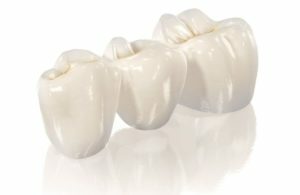 In the field of modern prosthetics, the crowns of cermets occupy, probably, the largest niche due to their high strength, aesthetics and quite acceptable cost.
In the field of modern prosthetics, the crowns of cermets occupy, probably, the largest niche due to their high strength, aesthetics and quite acceptable cost.
Metal ceramic crowns are a combination of several materials in one design, namely:
- Titanium alloys , from which the skeleton of the prosthesis is cast. The choice of titanium is due to its good adhesiveness to gum tissues and the resistance of alloys of a given metal to the oxidizing action of saliva. The specific composition of the alloy is determined based on the type of cement used to fix
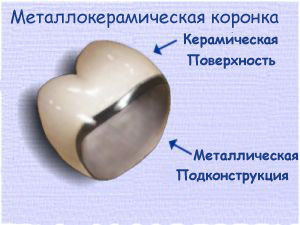 , the support( natural tooth or implant), the degree of destruction of hard dental tissue, the state of dentin, enamel and adjacent teeth. An alternative to titanium can be gold, cobalt-chrome or nickel alloys.
, the support( natural tooth or implant), the degree of destruction of hard dental tissue, the state of dentin, enamel and adjacent teeth. An alternative to titanium can be gold, cobalt-chrome or nickel alloys. - Ceramic cladding , which imitates in detail the texture of the enamel and its natural color.
Due to the structural features, the cermets are distinguished according to the type of alloy chosen. Also, there is a classification according to manufacturing technology:
- crowns with a shoulder mass ( the proportion of metal is much less than the share of ceramics, thanks to
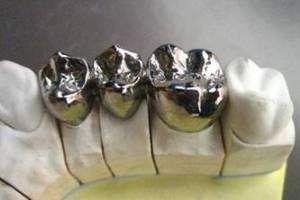 , the crown acquires the maximum aesthetics and strength);
, the crown acquires the maximum aesthetics and strength); - crowns obtained by milling ( it is possible to achieve full compliance with natural teeth);
- stamped prosthesis ( have a disadvantage in the form of insufficient accuracy of reproduction of tooth contours, which reduces the reliability of the crown).
Content
- tooth Preparation
- crown fabrication stages
- installation Features
- Indications for installation
- When should refuse to install
- Possible complications
- state Violation of the gingival margin
- Chronic gingivitis
- Advantages and disadvantages
- Rules care
- cost cermet and metalloplastmassy
- Life Questionedge - yet, which is better?
- Overheard and examined
Preparation of the tooth
Preparation and installation of the crown is preceded by a preliminary stage consisting of the following procedures:
- Complete treatment of the oral cavity with treatment of and sealing of carious cavities, elimination of pulpitis and periodontitis, removal of nerves and sealing of root canals subject to refraction of teethdepulpation can not be performed only when the crowns are placed on molars, if they are completely healthy).
- Strengthening of the upper part of the tooth in case of its severe destruction in order to ensure a reliable fixation of the seal .To do this, the tooth channel is sealed and a pin is inserted into it, which will become a support for filling materials. Next, a cultivated insert is cast in the laboratory, restoring the broken crown part.

Steps for making the crown
Immediately after the end of the complex preparation begins prosthetics, the first stage of which is the production of crowns of cermets. So, how to insert crowns:
-
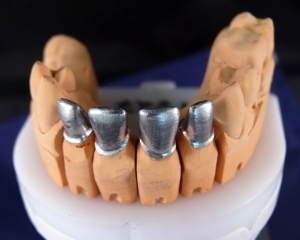 Prosthetized teeth grind on the thickness of future crowns;
Prosthetized teeth grind on the thickness of future crowns; - makes a cast of the jaw using a special material;
- send the impression to the dental laboratory to form a plaster model.
- using the received model, from a wax-like material, create a metal frame, transferring it to a workshop engaged in metal work;
- sample the finished frame on a plaster model or check the correctness of the manufacturing process on the patient at once to avoid mistakes;
- if the frame is suitable, it is sent back to the laboratory for coating with several layers of porcelain and roasting at a temperature of about 2000 degrees;
- modify the appearance and send the crown to the installation.
Features of the
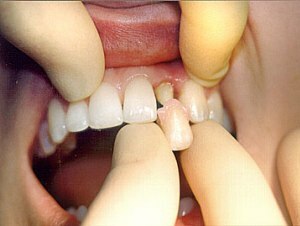 After receiving a ready prosthesis by a doctor, the patient needs to come to the fitting. If there are minor defects, the crown is corrected directly in the dental office.
After receiving a ready prosthesis by a doctor, the patient needs to come to the fitting. If there are minor defects, the crown is corrected directly in the dental office.
If major errors are detected, the prosthesis is sent to the laboratory for revision.
In case of absence of claims to the quality of manufacture, a temporary installation of cermets begins. The doctor necessarily stipulates the duration of the adaptation period, during which the body must get used to the prosthesis.
It usually does not exceed a few weeks. In the absence of a rejection reaction, the temporary cement is removed, and a permanent fixer is applied instead, which ensures the strength, stability and durability of the crown.
Indications for installation
Ceramic ceramic crowns are recommended for installation with:
- tooth decay more than half;
- clearly expressed forms of fluorosis( due to an excess of fluoride in the body begins the destruction of tooth enamel) or wedge-shaped defects;
- abnormal abrasion of the teeth;
- replacing crowns of plastic or metal;
- abnormal positioning of teeth, making it impossible for orthodontic treatment;
- need to splint teeth in the case of light or moderate periodontitis.
You can find out more about the features of metal-ceramic crowns by viewing this video:
When to abandon installation of
Do not perform prosthetics with cermet in the case of:
-
 development of acute periodontitis or periodontitis, in which the installation of prostheses only aggravates the pathological process;
development of acute periodontitis or periodontitis, in which the installation of prostheses only aggravates the pathological process; - exacerbation of infectious diseases;
- of a malocclusion that reduces the effectiveness of prosthetics due to global dental disorders;
- pregnancy or lactation;
- presence of bruxism( dental scraping).
Possible complications of
The success of the prosthesis depends on the quality of the restoration of the anatomical shape of the damaged tooth, which determines the correctness of the process of chewing food, proper correction of aesthetics and preservation of oral health in general.
If at some stage of the work there is an error, the use of a metal-ceramic crown can lead to the development of some complications.
Distortion of the gingival margin of the
May occur as a decrease in the volume of the gingival tissue, and their thickening, swelling as a result of the inflammatory process. 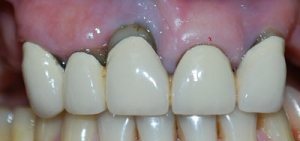
Simultaneously with the gingival margin, the papilla can be involved in the process in the area of the installed prosthesis.
Such changes are caused, as a rule, by poor-quality fit of the edge of the crown to the gum, its permanent trauma.
Chronic gingivitis
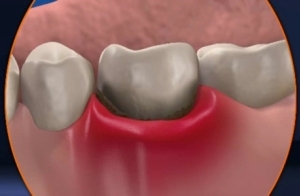 It is an aggravation of the complication described above and is manifested in the edema of soft tissues surrounding the crown, their bleeding. It is important to respond in a timely manner to such symptoms, not allowing the destruction of the prosthetic tissues of the tooth.
It is an aggravation of the complication described above and is manifested in the edema of soft tissues surrounding the crown, their bleeding. It is important to respond in a timely manner to such symptoms, not allowing the destruction of the prosthetic tissues of the tooth.
The reason for the negative changes, as in the first case, is poor-quality prosthetics with an impregnated preparation or forming a tooth model by not an unintelligible non-informative impression.
Unfortunately, it is possible to solve the problem in this situation only by manufacturing a new prosthesis.
Advantages and disadvantages of
The advantages of the cermets are:
- Good aesthetics of .In the case of high-quality production, due to the shade closest to natural teeth, the dentures fit harmoniously into the dentition.
- The strength of the and is the long life of the due to the non-abrasion-resistant ceramic lining. Very rarely there may be a slight cleavage of the ceramic mass, but such a defect is easily eliminated in the dentist's office.
- Preservation of the form even under the influence of significant chewing pressure, which is especially important for molar prosthesis.
- Heavy-Duty dovetailed supporting tooth and metal-ceramic construction.

Teeth before and after the installation of the cermets from cermet
. Among the negative moments are:
- Grinding of a significant proportion of dental tissues ( the minimum depth of grinding is about one and a half centimeters around the entire perimeter of the tooth).
- The need for tooth depopulation under the crown ( to avoid thermal burn of the pulp when turning) and root canal filling. Such an exercise is mandatory for the front teeth. If possible, lateral chewing teeth are kept alive to ensure their maximum strength.
- The presence of open end metal edges of the crown , which can be viewed with the loss of gums.
How to grind teeth for cermet:
Care instructions
When choosing metal-ceramic crowns, you can count on easy maintenance. To ensure that the prosthesis lasts as long as possible, the usual daily morning and evening brushing of the teeth is complemented by the use of a special irrigator for the oral cavity before going to bed, the dental floss after each meal. 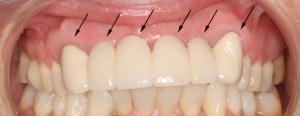
For the prevention of inflammatory processes, dental stone and subgingival plaque should be removed every six months in the dental office, and also points of overestimation on the chewing surface of the crowns in order to prevent their chipping.
Simultaneously with complex local events, it is important to monitor the overall health, proper nutrition, the presence in the diet of a sufficient number of vitamins that will properly feed the crowned tooth.
Cost of metal-ceramic and metal plastic
The price of a metal-ceramic crown depends on a number of factors:
- The manufacturer of the used material .When using Japanese or German ceramics and quality base alloy, the minimum average cost per prosthesis is about 6 thousand rubles, if domestic materials are used, you can expect the price to decrease to 4,5 thousand.
- Selection of alloy. When choosing a combination of gold with palladium or platinum, the average cost of the crown is about 17 thousand rubles.
- Use of temporary plastic crowns in the process of prosthetics .The price increases by about a thousand rubles.
Lifespan
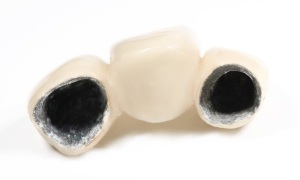 Usually in dental clinics where you decide to insert teeth, give a 12-month warranty. In general, the service life of metal-ceramic prostheses is from 8 to 10 years, provided the quality of manufacturing and proper installation.
Usually in dental clinics where you decide to insert teeth, give a 12-month warranty. In general, the service life of metal-ceramic prostheses is from 8 to 10 years, provided the quality of manufacturing and proper installation.
After the specified period, resorption of the fixing cement occurs and a breach of the tightness of the supporting tooth with an increased risk of developing secondary caries in it. Therefore, a new dental prosthetics is required.
The question is - yet, which is better?
Which teeth are better - cermet, metal plastic, ceramics, zirconium or stamped crown?
According to dental technicians and dentists, ceramic-coated zirconium crowns are much more aesthetically pleasing in appearance than ceramic-metal prostheses, and are equally durable. True, pay for zirconium crowns will have more, but with prosthetics of the front teeth, this option is still preferable.

On the photo of the crown of the front teeth: on the right zirconium, on the left, the metal-ceramic
. The metal plastic in comparison with the cermet is characterized by impermanence of color, fragility, inferior aesthetics, propensity to swell due to porous structure and transparency( therefore, these crowns are not mounted on the front teeth).
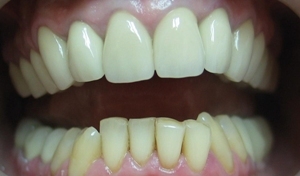
Metal-plastic crowns
Ceramic crowns are more fragile than ceramic-metal, but they do not adversely affect adjacent teeth, while metal-ceramic prostheses contribute to their erosion.
Also, ceramics are distinguished by hypoallergenicity, longer service life, higher aesthetics. The cost of such crowns is almost 2 times higher.
The most accessible in the price ratio are stamped crowns, but the appearance of such dentures leaves much to be desired.
Silvery or golden artificial teeth stand out sharply against the background of healthy teeth, so the aesthetics and beauty of the smile remain unattainable criteria.
Overheard and pending
The effective use of metal-ceramic prostheses and their reliability is confirmed by the following patient reviews.
Metal-ceramic crowns installed not only on the side, but also on the front teeth. The result did not bring disappointments, as the prostheses do not cause problems, they are easily cleaned of plaque, retain their color and do not wear off. Therefore, I am grateful to the dentist who skillfully performed the prosthetics and provided me with an ideal smile.
Inga, Moscow
In the first weeks after the installation of the cermet prosthesis, a small inflammation of the gum was noted, which I managed to cope with by rinsing. After that, there were no problems.
Anton, Lipetsk
Thus, crowns made of cermets are a kind of "golden mean" in terms of cost, quality and durability of operation between ceramic and plastic or metal prostheses.
Aesthetic appearance does not cause others to doubt that your smile is formed by your own teeth, and proper care will save the crown in its original form for as long as possible.
